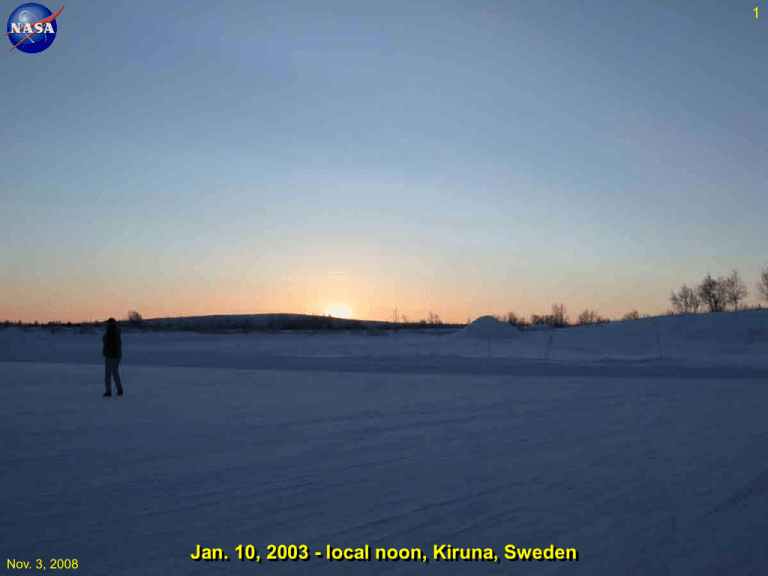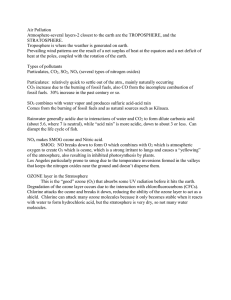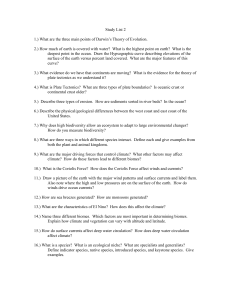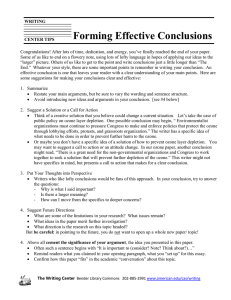Jan. 10, 2003 - local noon, Kiruna, Sweden 1 Nov. 3, 2008
advertisement

1 Nov. 3, 2008 Jan. 10, 2003 - local noon, Kiruna, Sweden 2 Jan. 14, 2003 Southern Norway Nov. 3, 2008 3 Polar Stratospheric Ozone Dr. Paul A. Newman http://code613-3.gsfc.nasa.gov/People/Newman/ NASA’s Goddard Space Flight Center IPY Webcast NASA GSFC Nov. 3, 2008 Nov. 3, 2008 4 Ozone Basic Facts O3 = Ozone is composed of 3 oxygen atoms. Ozone O3 concentrations are small (peak concentrations are about 10 parts per million at an altitude of about 32 km (20 miles). O3 absorbs harmful solar ultraviolet radiation. A necessary condition for life. O3 is mainly found in the the stratosphere. Oxygen O3 at the ground is a problem! Inhalation of ozone for very small concentrations can cause lung problems . Mass: (Billion Metric Tons) Sun 1,9900,000,000,000,000,000 Earth 5,980,000,000,000 Global atmosphere 5,300,000 Global ozone 3 Nov. 3, 2008 5 Atmospheric Composition • • • • Nitrogen Oxygen Argon Water • CO2 • O3 Nov. 3, 2008 78.1% 20.9% 0.9% 1.4% (tropics) 0.2% (poles) 0.0004% (stratosphere) 0.0360% 0.001% (stratosphere) 0.00001% (troposphere) 6 Atmospheric Structure -135oF -99oF -63oF -27oF 9 oF 45oF 81oF 100 60 Thermosphere Altitude (km) 50 Mesosphere Altitude (miles) 80 40 60 30 40 Stratosphere 20 20 10 Troposphere 0 180 200 220 240 260 Temperature (K) Nov. 3, 2008 280 0 300 7 Atmospheric Structure 100 60 Thermosphere Altitude (km) 50 Mesosphere Altitude (miles) 80 40 60 30 40 Stratosphere 20 20 Airliners fly at 30,000-40,000 feet 10 Troposphere 0 Nov. 3, 2008 0 8 Atmospheric Structure 100 60 Thermosphere Altitude (km) 50 Mesosphere Altitude (miles) 80 40 60 30 40 ER-2 flies at 70,000 feet Stratosphere 20 20 10 Troposphere 0 Nov. 3, 2008 0 9 Atmospheric Structure 100 60 Thermosphere Altitude (km) 50 Mesosphere Altitude (miles) 80 40 60 30 40 Oxygen Ozone Stratosphere 20 20 10 Troposphere 0 Nov. 3, 2008 0 10 Ozone Facts QuickTi me™ a nd a TIFF (Uncompre ssed ) decomp resso r are need ed to se e th is p icture. 100 60 Thermosphere Altitude (km) 50 Mesosphere Altitude (miles) 80 40 60 30 40 90% of ozone is in the stratosphere 20 20 10 Troposphere 0 0 2 4 6 Ozone (parts per million) Nov. 3, 2008 8 0 11 Ozone Facts 100 60 Thermosphere Altitude (km) 50 Mesosphere Altitude (miles) 80 40 60 30 40 Stratosphere 20 20 10 10% of ozone is in the troposphere 0 0 2 4 6 Ozone (parts per million) Nov. 3, 2008 8 0 12 Digression: Dobson Units • Total Ozone is a measure of the total column amount above us. Measured in Dobson Units • If we bring all of the ozone above us down to the Earth’s surface • The thickness would be about 3 millimeters (~0.1 inches) = 300 Dobson Units (approximately the global average) • 100 Dobson Units = 1 millimeter in thickness 2¢ 10¢ 3 mm = 300 Dobson Units Nov. 3, 2008 The Dobson Unit is a convenient unit of measurement for total column ozone 13 Ozone Facts Ozone is the Earth’s natural sunscreen 60 80 UVc - 100% Absorption UVb - 90% Absorption UVa - 50% Absorption & Scattering 60 50 Altitude (miles) Altitude (km) 100 40 30 40 Stratosphere 20 20 10 0 0 2 4 6 Ozone (part per million) Nov. 3, 2008 8 0 14 UV Health Facts • UV pluses: produces vitamin D in the skin necessary to maintain levels of calcium and phosphorus (10-15 minutes twice a week) • UV minuses: – Eye damage: cataracts, photokerititus (snowblinding), ocular cancers – Skin cancers: basal, squamous, melanoma – photoaging – Damage to various land speciesDamage to aquatic species – Increased pollution levels in urban environments Nov. 3, 2008 QuickTime™ and a TIFF (Uncompressed) decompressor are needed to see this picture. Cataract Melanoma QuickTime™ and a TIFF (Uncompressed) decompressor are needed to see this picture. Mexico City 15 Large polar ozone losses result from chlorine and bromine compounds that are mainly human produced Nov. 3, 2008 Chlorine Pathway Cl catalytically destroys O3 Cl reacts with CH4 or CFC-12 photolyzed in NO2 to form nonstratosphere by solar UV, reactive HCl or releasing Cl ClONO2 Polar loss Carried into stratosphere in the tropics by slow rising circulation CFC-12 released in troposphere Nov. 3, 2008 16 17 Source Gases 1% 4% 5% 7% 3400 3000 Other gases Methyl chlor oform (CH3CCl3) HCFCs (e.g., HCFC-22 = CHClF2) CFC-113 (CCl2FCClF2) Other halons 20 Carbon tetrachloride (CCl4) 12% 14% Halon-1301 (CBrF 3) Halon-1211 (CBrCIF 2) 15 CFC-11 (CCl3F) 20% 5-20% 2000 23% 4% Methyl bromide (CH 3Br) 10 CFC-12 (CCl2F2) 1000 5 32% 0 Natural sources 16% 27-42% Methyl chloride (CH3Cl) 0 Very-short lived gases (e.g., bromoform = CHBr 3) 15% • Cl is much more abundant than Br, but … • Br is about 60 times more effective at O3 destruction Nov. 3, 2008 From Ozone FAQ - see http://www.unep.org/ozone/faq.shtml Atmospheric Chlorine Trends from NOAA/ERL - Climate Monitoring Division 18 102 years CFC-12 CFC-11 CCl4 CFC-113 CH3CCl3 Nov. 3, 50 years 42 years 85 years 5 years Updated Figure made by Dr. James Elkins from Trends of the Commonly Used Halons Below Published by Butler et al. [1998], 2008All CFC-113 from Steve Montzka (flasks by GC/MS), and recent updates of all other gases from Geoff Dutton (in situ GC). 19 Polar Stratospheric Clouds Central, Sweden January 14, 2003 - P. Newman Nov. 3, 2008 20 Antarctic ozone hole theory Solomon et al. (1986), Wofsy and McElroy (1986), and Crutzen and Arnold (1986) suggest reactions on cloud particle surfaces as mechanism for activating Chlorine HCl Cl2 ClONO2 Nov. 3, 2008 HNO3 Cl2 is easily photolyzed by UV & blue/green light HNO3 is sequestered on PSC 21 Polar Ozone Destruction 1. O3 + Cl ClO + O2 3. ClOOCl+h2 Cl+O2 2 O3 3 O2 2. 2 ClO + M ClOOCl + M Only visible light (blue/green) needed for photolyzing ClOOCl No oxygen atoms required Nov. 3, 2008 Net: 2O3 + h 3O2 Antarctic Measurements Nov. 3, 2008 Aurora over Halley Bay Station, Antarctica, 75.6ºS 26.5ºE Brunt Ice Shelf, Coats Land 105 days of continuous darkness, twice per year re-supply Population: 65 in summer, 15 in winter 22 23 October Antarctic Ozone pre-1985 Nov. 3, 2008 24 October Antarctic Ozone Nov. 3, 2008 25 TOMS - August 31, 2003 Orange/Yellow indicates higher ozone levels. Dark color over pole shows the extent of polar night, no ozone observations Nov. 3, 2008 Antarctic ozone hole is defined as the region covered by low ozone values Blue colors indicate low ozone values Ozone Hole Area Sep. 21, 2008 N. America Sep. 30, 2008 1st observed SH major warming (2002) 10/25/2008 26 27 October Average Ozone Hole Nov. 3, 2008 28 March Average total ozone Nov. 3, 2008 29 Arctic & Antarctic Trends Nov. 3, 2008 30 What’s being done? Nov. 3, 2008 31 What Can You Do? • Avoid excessive solar exposure (limit sun between 11AM and 2PM). • Wear and encourage others to wear sunscreen (SPF rating of 15). Even with sunscreen, prolonged exposure is not smart. • Check your skin regularly. • Wear sunglasses that screen UV. • Hats and other coverings • Make note of the UV index on the news or web: http://www.epa.gov/sunwise/uvindex.html Nov. 3, 2008 Atmospheric Chlorine Trends from NOAA/ERL - Climate Monitoring Division 32 102 years CFC-12 CFC-11 50 years U. S. CFC production stopped by President George Bush in 1992 CCl4 Montreal Protocol Signed (1987) CFC-113 CH3CCl3 Nov. 3, 42 years 85 years 5 years Updated Figure made by Dr. James Elkins from Trends of the Commonly Used Halons Below Published by Butler et al. [1998], 2008All CFC-113 from Steve Montzka (flasks by GC/MS), and recent updates of all other gases from Geoff Dutton (in situ GC). Antarctic EESC Obs. Projections Using WMO scenario A1-adj., we can project forward from 1980 to show recovery of EESC around 2065. Recovery of 1970 Antarctic EESC in 22nd century! 10/25/2008 33 34 Ozone future Projected area of the ozone hole Nov. 3, 2008 35 Summary • Stratospheric ozone is a critical gas for screening solar UV radiation. • Human produced ozone destroying substances (ODS) have caused large losses of polar ozone over both poles • ODSs have been regulated under international agreements and are slowly decreasing. Ozone levels should recover within the next 50-70 years. • Climate change remains a big unknown for ozone recovery Nov. 3, 2008





